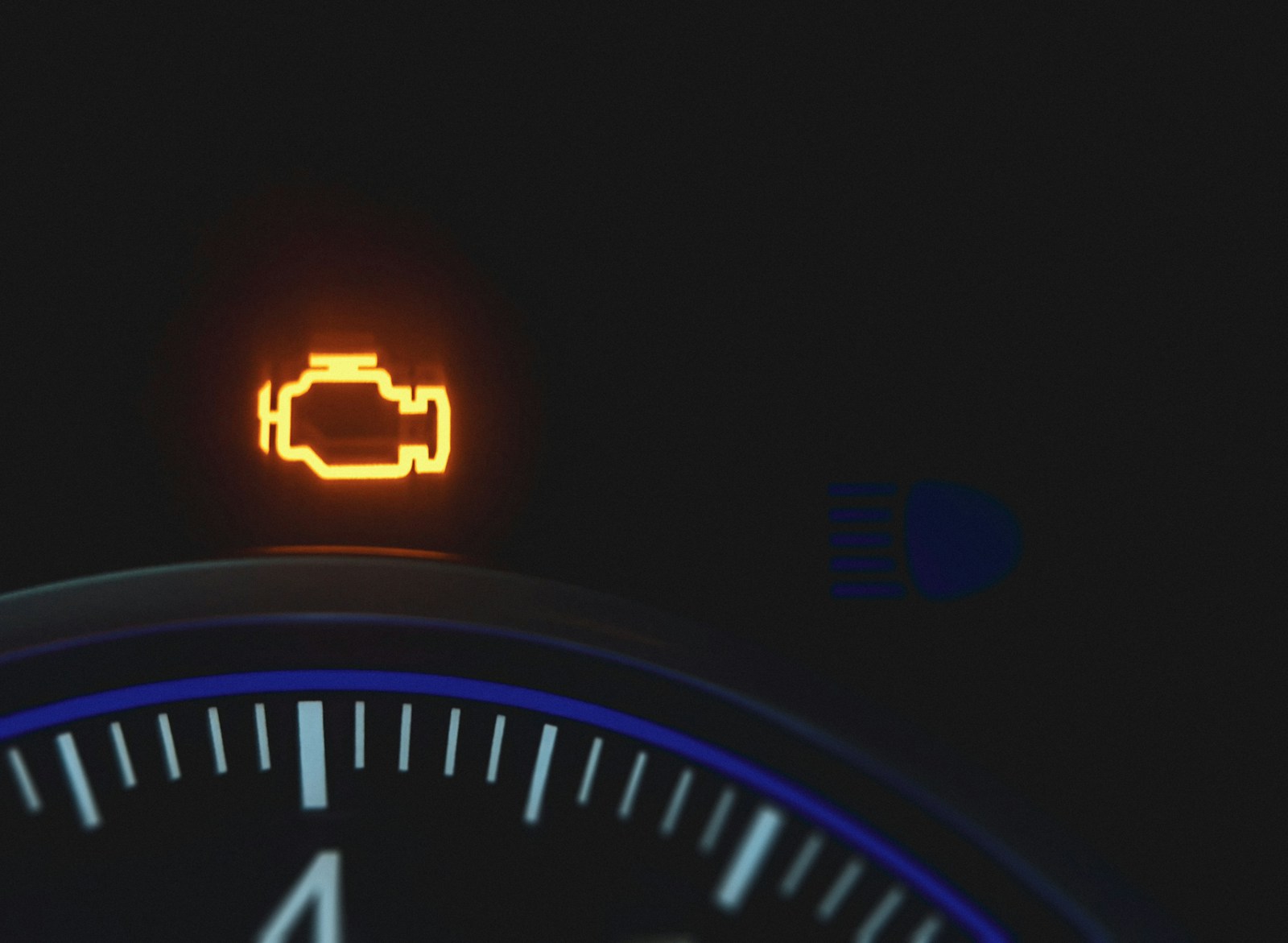Seeing a check engine light that turns on and off can be confusing and concerning for many drivers. This warning indicator is designed to alert you to potential problems with your vehicle’s engine or emissions system. A check engine light that comes on and off intermittently often indicates minor issues such as a loose gas cap, faulty oxygen sensor, bad spark plugs, or problems with the mass airflow sensor.
These fluctuations in your dashboard warning light don’t always signal a major emergency, but they shouldn’t be ignored either. When your check engine light behaves erratically, it means your car’s computer system is detecting an intermittent problem that may worsen over time. The light typically illuminates when you start your car as part of a system check, but if it continues to flash or turns on and off while driving, your vehicle is trying to tell you something.
Common Reasons Your Check Engine Light Turns On and Off
Few things make drivers more anxious than seeing that little amber engine icon pop up on the dashboard—especially when it turns off again before you can figure out what’s going on. If your check engine light (CEL) keeps coming on and off, it’s usually a sign that something isn’t quite right, even if it seems minor at first. Here are the most common culprits.

1. Loose or Faulty Gas Cap
One of the simplest (and most overlooked) reasons for a check engine light is a loose or damaged gas cap. If the cap isn’t tightened properly, it can trigger the car’s evaporative emission system to detect a leak, causing the CEL to illuminate. Sometimes, after tightening the cap, the light turns off after a few driving cycles.
What to do: Check the gas cap. Make sure it clicks securely when you close it. If it’s cracked or damaged, replace it—caps are cheap and easy to find at most auto parts stores.
2. Intermittent Sensor Issues
Your vehicle relies on a network of sensors—like oxygen sensors and mass airflow sensors—to monitor performance and emissions. If one of these sensors gives inconsistent readings, it can cause the CEL to flicker on and off.
What to do: These sensors usually throw stored trouble codes, even if the light turns off. A quick scan with an OBD-II scanner (most auto parts stores offer free scans) can reveal the issue.
3. Engine Misfire or Temporary Performance Glitch
A temporary engine misfire—from something like bad fuel or a clogged injector—can trigger the light. If the problem corrects itself (like when better fuel flows through), the CEL may turn off on its own.
What to do: If it happens once and doesn’t return, it may have been a one-off. But if the light keeps cycling on and off, it’s time to get the vehicle checked out.
4. Catalytic Converter Problems
A failing catalytic converter may cause sporadic check engine warnings, especially if emissions spike and then stabilize. This isn’t something to ignore—a bad catalytic converter can lead to poor performance and costly repairs.
What to do: If your car smells like rotten eggs, has sluggish acceleration, or guzzles gas, you might have a converter issue. Get a diagnostic scan to confirm.
5. Faulty Spark Plugs or Ignition Coils
Worn spark plugs or failing ignition coils can cause intermittent misfires, leading to fluctuating CEL warnings. Your engine may run fine for a while, then stumble or hesitate, triggering the light.
What to do: Replacing spark plugs is a basic maintenance task, often recommended every 30,000-100,000 miles depending on the vehicle. Ignition coils can also wear out over time and are easy for a mechanic to diagnose and replace.
Should You Be Worried About a Check Engine Light That Turns On and Off?
When the check engine light flashes briefly and then disappears, it’s tempting to shrug it off. But intermittent warnings often point to a problem that’s just starting—or one that comes and goes under certain conditions.
The light turning off doesn’t mean the issue fixed itself. Modern cars are designed to recheck systems constantly, and if the conditions causing the problem aren’t present, the light might go dark. But the system still logs a trouble code in the computer, which a scan tool can retrieve.
What To Do If Your Check Engine Light Comes On and Off
1. Inspect the Gas Cap
As mentioned earlier, always start with the simplest fix. Check the gas cap and make sure it’s secure.
2. Use an OBD-II Scanner
You can buy a simple scanner online or stop by most auto parts stores (AutoZone, O’Reilly, etc.) for a free diagnostic check. Even if the CEL turns off, the code history may give clues about what’s happening.
3. Keep an Eye on Your Car’s Behavior
If you notice changes like rough idling, poor acceleration, or bad fuel economy, these are signs you shouldn’t wait around. Schedule an inspection before minor issues become major ones.
When to Seek Professional Help
If the CEL flashes (rather than a steady light), this typically indicates a serious misfire that could damage your catalytic converter. Pull over and call a mechanic if it happens while you’re driving.
For persistent on-and-off CELs, have a qualified technician run a comprehensive diagnostic test. They’ll pinpoint whether it’s a sensor glitch, emissions problem, or something more serious.
Key Takeaways
- An intermittent check engine light often indicates minor issues like a loose gas cap or faulty sensors that should be addressed promptly.
- Modern vehicles have onboard diagnostic systems that can identify the specific problem causing the warning light to appear.
- Regular maintenance and prompt attention to warning lights can prevent small issues from developing into costly repairs.
Understanding the Check Engine Light
A check engine light that turns on and off may not feel like an emergency, but it’s your vehicle’s way of telling you something’s up. Ignoring it could lead to bigger problems down the road—literally. Stay proactive, run a diagnostic scan, and address issues early to keep your car running smoothly.
The check engine light (CEL) serves as a critical warning system in modern vehicles. It alerts drivers to potential issues with the engine or emission control systems before they become serious problems.
Functions of the Check Engine Light
The check engine light is part of your vehicle’s onboard diagnostics system. This system monitors various components, including the engine, transmission, exhaust system, and fuel system. When the computer detects an issue outside normal parameters, it triggers the light to notify the driver.
The CEL helps protect your vehicle from damage by providing early warnings. It stores specific trouble codes that mechanics can retrieve using diagnostic tools. These codes point to particular systems or components experiencing problems.
Most modern vehicles have sophisticated monitoring systems that can detect even small issues like loose gas caps or minor sensor malfunctions. The light doesn’t always indicate a catastrophic problem, but it should never be ignored.
Types of Check Engine Lights: Solid and Flashing
A solid check engine light typically indicates a non-emergency issue that should be checked soon. This might include problems like a loose gas cap, minor sensor failures, or emission control issues. While not requiring immediate action, these problems should be diagnosed within a reasonable timeframe to prevent further complications.
A flashing check engine light, by contrast, signals a serious problem that requires immediate attention. This warning indicates an issue that could damage your catalytic converter or other expensive components. When the CEL flashes, you should reduce speed immediately and take your vehicle to a mechanic as soon as possible.
Some newer vehicles use color-coded warning lights. Yellow or amber typically indicates a non-critical issue, while red suggests a more serious problem requiring immediate attention. The owner’s manual will explain your specific vehicle’s warning system.
Common Reasons for Check Engine Light Activation
The check engine light serves as a critical warning system in your vehicle, alerting you to potential issues that require attention. When this dashboard indicator illuminates, several common culprits are typically responsible.
Loose or Faulty Gas Cap
A loose, damaged, or missing gas cap is among the simplest yet most common reasons for check engine light activation. This small component plays a vital role in your vehicle’s fuel system by maintaining proper pressure and preventing fuel vapors from escaping.
When a gas cap isn’t properly secured or is damaged, your vehicle’s evaporative emission (EVAP) system detects the pressure change and triggers the check engine light. This issue can reduce fuel efficiency and increase harmful emissions.
To fix this problem:
- Remove the gas cap and inspect it for cracks or damage
- Clean the cap and the area around the fuel filler neck
- Reinstall the cap, turning until you hear clicking sounds (usually 3-4 clicks)
If the light remains on after tightening the cap, drive for about 50-100 miles as the system may need time to reset. If the light persists, the cap might need replacement.
Faulty Oxygen Sensor
Oxygen sensors monitor the amount of unburned oxygen in your vehicle’s exhaust system. These sensors help regulate the air-fuel mixture, ensuring optimal engine performance and emissions control.
When an oxygen sensor fails, it can cause:
- Decreased fuel efficiency (up to 40% reduction)
- Increased emissions
- Rough idling or stalling
- Potential damage to catalytic converters
Modern vehicles typically have between 2-4 oxygen sensors positioned before and after the catalytic converter. When one malfunctions, the engine management system can’t properly adjust the air-fuel ratio.
Replacement costs vary between $100-$300 per sensor, depending on your vehicle make and model. While oxygen sensors should last 60,000-100,000 miles, contamination from rich fuel mixtures or engine oil can shorten their lifespan.
Malfunctioning Mass Airflow Sensor
The mass airflow (MAF) sensor measures the amount of air entering the engine. This critical data helps the engine control unit determine how much fuel to inject for optimal combustion.
When the MAF sensor fails, it often results in:
- Poor acceleration
- Engine stalling
- Rough idling
- Decreased fuel economy
- Difficulty starting the engine
MAF sensors typically become contaminated with dirt, oil, or debris over time. In some cases, a simple cleaning may resolve the issue. Use a specialized MAF sensor cleaner spray rather than general cleaners to avoid damage.
Replacement costs range from $150-$400 depending on vehicle type. Regular air filter maintenance can help prevent MAF sensor issues, as can avoiding short trips that don’t allow the engine to reach operating temperature.
Worn or Bad Spark Plugs/Plug Wires
Spark plugs and their wires are essential for igniting the air-fuel mixture in your engine’s combustion chambers. When these components deteriorate, your engine’s performance suffers significantly.
Signs of failing spark plugs or wires include:
- Engine misfires
- Rough idling
- Poor acceleration
- Increased fuel consumption
- Difficulty starting the vehicle
Spark plugs typically last between 30,000-100,000 miles depending on the type (copper, platinum, or iridium). Plug wires can last 60,000-100,000 miles but may deteriorate faster in high-heat conditions.
Replacing spark plugs costs approximately $16-$100 for parts, while professional installation might add $40-$150 in labor. Many vehicle owners can replace spark plugs themselves with basic tools and mechanical knowledge. Always consult your vehicle’s manual for the correct spark plug gap specifications and torque settings.
The Role of Vehicle’s Emissions System
Your vehicle’s emissions system is designed to reduce harmful pollutants released into the atmosphere. This complex system includes several components that work together to minimize environmental impact while maintaining engine performance.
Catalytic Converter Issues
The catalytic converter is a vital emissions component that transforms harmful exhaust gases into less toxic substances. When functioning properly, it converts carbon monoxide, nitrogen oxides, and hydrocarbons into carbon dioxide, nitrogen, and water vapor.
A failing catalytic converter often triggers the check engine light. Common symptoms include decreased engine performance, reduced fuel economy, and a sulfur smell (like rotten eggs) from the exhaust.
The converter can fail due to age, contamination from oil or coolant, or damage from road debris. In some cases, it becomes clogged from excessive carbon buildup or melts internally from engine misfires.
Replacing a bad catalytic converter is expensive but necessary for both emissions compliance and vehicle performance. Driving with a failed converter can lead to engine damage and is illegal in most states due to emissions regulations.
Exhaust Gas Recirculation (EGR) Valve
The EGR valve reduces nitrogen oxide emissions by recirculating a portion of exhaust gases back into the engine’s combustion chambers. This lowers combustion temperatures and reduces pollution.
When the EGR valve malfunctions, your check engine light typically activates. Common symptoms include:
- Engine pinging or knocking
- Rough idle or stalling
- Increased fuel consumption
- Failed emissions tests
The valve often fails from carbon buildup that prevents proper opening and closing. This happens gradually as exhaust deposits accumulate, eventually causing the valve to stick in either open or closed position.
Cleaning the EGR valve may resolve the issue if caught early. However, a severely damaged or stuck valve requires replacement. Regular maintenance helps prevent EGR system failures and keeps your emissions system functioning properly.
Engine and Performance Issues
Engine and performance problems often cause check engine lights to fluctuate between on and off states. These issues can significantly affect your vehicle’s operation and may worsen if not addressed promptly.
Engine Misfires
Engine misfires occur when the combustion process in one or more cylinders fails to work properly. When a misfire happens, the check engine light may flash or come on intermittently. This usually indicates something is wrong with the ignition system.
Common causes of engine misfires include:
- Worn or fouled spark plugs
- Damaged ignition coils
- Faulty fuel injectors
- Low compression in one or more cylinders
- Vacuum leaks
Misfires often create noticeable symptoms like rough idling, hesitation during acceleration, and jerking motions while driving. The vehicle’s computer may detect these intermittent problems, causing the check engine light to turn on and off as conditions change.
Ignoring misfires can lead to catalytic converter damage, reduced power, and decreased fuel economy. A mechanic can diagnose the specific cylinder with issues using an OBD-II scanner.
Overheating Engine
An overheating engine frequently triggers the check engine light’s on-off behavior. Modern vehicles have temperature sensors that monitor the engine’s operating temperature and alert the onboard computer when levels become dangerous.
Several issues can cause engine overheating:
- Low coolant levels or coolant leaks
- Malfunctioning thermostat
- Failed water pump
- Blocked radiator
- Broken cooling fan
When the engine temperature rises and falls, the check engine light may illuminate temporarily until temperatures normalize. This pattern often occurs in stop-and-go traffic or during hot weather.
Engine overheating should never be ignored. Continued operation of an overheating engine can cause severe damage including warped cylinder heads, blown head gaskets, or even complete engine failure.
Reduced Fuel Efficiency
When your check engine light comes on and off, you might notice decreased fuel efficiency. This reduction often signals that your engine isn’t operating at peak performance. The vehicle’s computer continuously monitors fuel consumption patterns.
Many fuel-related issues can trigger intermittent check engine lights:
- Dirty or failing oxygen sensors
- Clogged fuel injectors
- Malfunctioning mass airflow sensor
- Carbon buildup in the intake system
- Bad fuel pressure regulator
You might notice your vehicle requiring more frequent refueling or the fuel gauge dropping faster than normal. These symptoms, combined with an intermittent check engine light, strongly suggest fuel system problems.
Modern vehicles have sophisticated systems that adjust fuel mixtures based on driving conditions. When these systems detect abnormalities, they may trigger temporary check engine warnings while attempting to compensate for the issues.
Diagnostic and Troubleshooting
When a check engine light fluctuates between on and off, proper diagnosis is essential to identify the underlying issue. Modern vehicles have sophisticated onboard computer systems that can provide valuable information about potential problems.
Using an OBD-II Diagnostic Scanner
An OBD-II diagnostic scanner is the most reliable tool for determining why a check engine light is coming on and off. These devices plug into the OBD-II port typically located under the dashboard near the steering column.
Basic scanners cost between $20-$100 and can read and clear codes. More advanced models ($100-$300) offer enhanced features like live data streams and freeze frame information.
To use a scanner:
- Locate the OBD-II port in your vehicle
- Plug in the scanner with the ignition off
- Turn the key to the “on” position (don’t start the engine)
- Follow the scanner’s instructions to read codes
Many auto parts stores offer free code scanning services if you don’t own a scanner. This can save you diagnostic fees at repair shops, which typically range from $50-$150.
Interpreting Trouble Codes
Trouble codes follow a standardized format with a letter prefix followed by four digits. The prefix indicates the system affected:
- P codes relate to powertrain (engine, transmission)
- B codes indicate body issues
- C codes refer to chassis components
- U codes point to network communication problems
The first digit after the letter shows if the code is generic (0) or manufacturer-specific (1). The remaining digits pinpoint the exact issue.
Common check engine codes include P0420 (catalytic converter efficiency), P0300 (random misfire), and P0171 (system too lean). Write down all codes displayed as some may be related.
Remember that codes are starting points for diagnosis, not definitive answers. They indicate which system has a problem but often require further investigation to determine the root cause.
Electrical Problems
Electrical issues in your vehicle can trigger intermittent check engine lights as they directly affect how your car’s computer systems function. These problems can range from simple battery connections to complex ECU malfunctions.
Issues with the Car Battery
A weak, damaged, or poorly connected car battery can cause the check engine light to flicker on and off. When battery voltage drops below a certain threshold, the ECU may not receive sufficient power to operate properly, triggering warning lights.
Corroded battery terminals often create intermittent electrical connections. This can cause voltage fluctuations that confuse the vehicle’s computer systems.
Signs of battery problems include:
- Dim headlights
- Difficulty starting the vehicle
- Electronics that work intermittently
- Dashboard lights that flicker
Testing battery voltage is simple with a multimeter. A healthy battery should read approximately 12.6 volts when the engine is off and 13.7 to 14.7 volts when running.
Problems in the Electronic Control Unit (ECU)
The ECU is your car’s main computer that monitors and controls engine performance. When it experiences electrical issues, the check engine light may come on temporarily and then disappear.
Water damage is one of the most common ECU problems. Even small amounts of moisture can cause short circuits that trigger warning lights.
Loose wiring connections to the ECU can create intermittent problems. As you drive, vibrations might temporarily disconnect and reconnect these wires.
Age-related ECU failures often begin with sporadic check engine lights before complete failure occurs. Most modern ECUs are designed to last the vehicle’s lifetime, but extreme temperatures and electrical surges can shorten their lifespan.
ECU diagnostics typically require specialized equipment. An automotive technician can perform a full system scan to identify specific faults within the computer.
Maintenance and Professional Assistance
Proper vehicle maintenance and knowing when to seek professional help can prevent check engine light issues from becoming major problems. These preventative measures can save money and extend vehicle life.
Importance of Regular Maintenance
Regular maintenance is crucial for preventing check engine light issues. Following the manufacturer’s recommended service schedule helps catch potential problems before they trigger warning lights.
Simple tasks like changing the oil, replacing air filters, and checking fluid levels can prevent many common check engine light triggers. Oil changes are particularly important as dirty oil can damage engine components and trigger sensor readings.
Inspecting and replacing worn spark plugs can eliminate misfires that often cause intermittent check engine lights. Regularly checking and tightening the gas cap can prevent evaporative emissions system codes.
Keeping fuel injectors clean through periodic fuel system cleanings helps maintain proper engine operation. Battery terminals should be kept clean and connections tight to prevent electrical issues.
When to Consult a Professional Mechanic
While some check engine light issues can be addressed by car owners, certain situations require professional expertise. If the light comes on and stays on, especially if accompanied by performance issues, seek professional help promptly.
A mechanic should be consulted when:
- The light flashes (indicating potential catalytic converter damage)
- Strange engine noises occur with the warning light
- Vehicle performance noticeably decreases
- The light returns after being reset
- Multiple warning lights appear simultaneously
Driving with a check engine light on is generally safe for short distances if the vehicle runs normally. However, a flashing light signals a severe problem requiring immediate attention to prevent expensive damage.
Professional diagnostic equipment can read and interpret trouble codes accurately. Most repair shops offer diagnostic services for reasonable fees, often applying the cost toward repairs if performed at their facility.
For intermittent check engine lights, mechanics can review freeze frame data to diagnose issues that aren’t actively present during inspection.
Check Engine Light Fluctuations
When your check engine light turns on then off intermittently, it can be confusing and concerning. This fluctuation often points to an intermittent issue that needs attention before it potentially becomes more serious.
Explaining the Check Engine Light On and Off Phenomenon
The check engine light is controlled by your vehicle’s onboard computer system (ECM or ECU). When this light flickers or alternates between being on and off, it typically indicates an intermittent problem. Common causes include a loose gas cap, which can trigger the evaporative emissions system to detect a leak. Once tightened properly, the light may go off by itself.
Some issues are temporary in nature. Your car’s computer needs to detect a problem multiple times before permanently illuminating the warning light. If a sensor reading falls in and out of acceptable ranges, the light might appear and disappear accordingly.
Even when the light turns off, the computer often stores the error code. These codes can be read with a diagnostic scanner even after the light disappears. This is why mechanics can still find problems even when your dashboard looks normal.
Low oil levels or pressure problems can also cause the light to fluctuate. After an oil change, make sure the dipstick and oil fill cap are properly seated to avoid triggering the warning light.
Never ignore a check engine light that comes and goes. This pattern often precedes a more serious problem developing.







